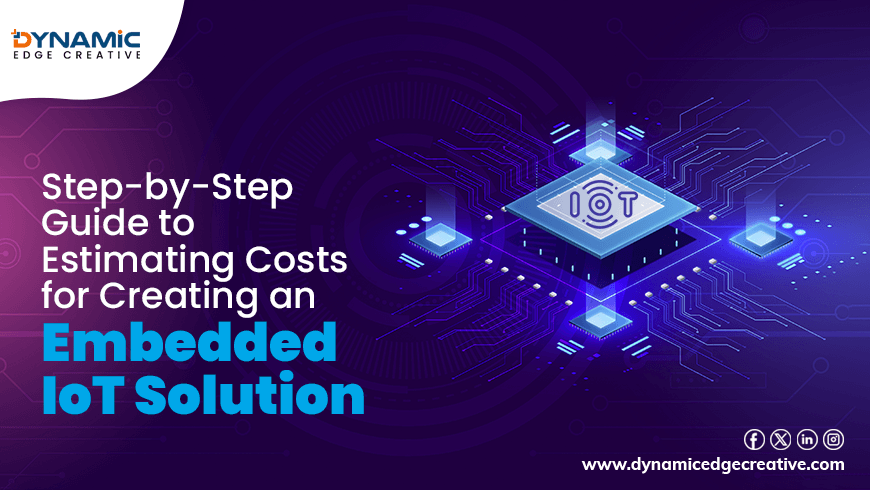
- Table Of Content
- Understanding the Scope of Your IoT Solution
- Hardware Costs
- Software Development Costs
- Connectivity and Data Management Costs
- Labor and Development Team Expenses
- Manufacturing and Production Costs
- Licensing, Certifications, and Compliance
- Post-Deployment and Maintenance Costs
- Unexpected Costs and Contingencies
- Conclusion
In today’s tech setting, trends like edge computing and AI automation are shaping the way embedded IoT solutions are designed and deployed. Understanding the financial aspects of an Embedded IoT Solution has become more complex than ever. This is due to the rapid rise of smart devices and connectivity.
Integrating AI analytics and edge computing into IoT systems makes cost estimation even more vital. No worries! This guide will explain the process which ensures your project is financially sound from start to finish.
Understanding the Scope of Your IoT Solution
You must understand the scope of your IoT solution to complete a successful project. It involves defining the specific objectives, functionalities, and end-user needs that the solution aims to address.
You can determine the necessary hardware, software, connectivity, and data management requirements by clearly outlining the scope. This step also helps in identifying potential challenges and limitations early in the process. This leads to better planning and resource allocation.
Hardware Costs
Hardware costs are a significant component of developing an embedded IoT solution. These costs include expenses for microcontrollers, sensors, communication modules, and power management systems that enable the device to function and connect to the IoT network.
The choice of hardware depends on factors like processing power, memory requirements, and environmental durability. These can vary greatly based on the application. Custom hardware design, prototyping, and testing can add to the overall expense.
Software Development Costs
Software development costs are a critical aspect of creating an embedded IoT solution. These expenses cover the development of firmware, application software, and user interfaces. This enable the device to function and communicate with other systems.
Costs can vary depending on the complexity of the software. It may include the need for real-time processing, data encryption, and custom algorithms. Additionally, integrating the software with existing platforms, testing, debugging, and ongoing updates add to the overall cost.
Accurately estimate software development costs to ensure your project stays within budget. So that you can focus on delivering a robust and user-friendly IoT solution.
Connectivity and Data Management Costs
Connectivity and data management costs leads to the smooth operation of an embedded IoT solution. These costs include expenses for network protocols, SIM cards, data transmission, and cloud services that enable devices to communicate and store data.
The choice of connectivity-Wi-Fi, cellular, Bluetooth, or LoRa-affects upfront and ongoing costs. Data management involves storing, processing, and analyzing large volumes of data. It often requires scalable cloud solutions or edge computing resources.
These costs ensure reliable and secure data flow while keeping the solution cost-effective and efficient.
Labor and Development Team Expenses
Labor and development team expenses are major contributors to the overall cost of an embedded IoT solution. These costs include salaries for developers, engineers, project managers, and other specialists who work on design, develop, and maintain the solution.
The complexity of the project often dictates the size and expertise of the team. It also influences the costs. Additionally, training, collaboration tools, and project management software expenses can also have added up with this.
The estimation of labor and development team expenses really matters a lot. This makes sure the project is staffed appropriately while staying within budget and timeline constraints.
Manufacturing and Production Costs
You should never miss manufacturing and production costs when scaling an embedded IoT solution from prototype to mass production. These costs include the fabrication of hardware components, assembly, quality control, and testing.
Expenses for materials, packaging, and logistics are part of the production process. The choice of manufacturing partners, production volume, and design complexity can influence the costs.
Properly estimate manufacturing and production costs to achieve cost efficiency while maintaining high-quality standards for the final product.
Licensing, Certifications, and Compliance
next you should focus on licensing, certifications, and compliance costs. These insist that an embedded IoT solution meets industry standards and regulations. These expenses cover obtaining necessary patents, licenses, and certifications.
Check for compliance with regulatory requirements like FCC or CE certifications. So that your device can be legally marketed and sold in different regions.
Keep an eye on ongoing costs for maintaining compliance and updating certifications. Accurately estimating these costs helps prevent legal issues and delays. This ensures that the IoT solution adheres to all necessary standards.
Post-Deployment and Maintenance Costs
Post-deployment and maintenance costs will influence the long-term success of an embedded IoT solution. These expenses include regular updates, bug fixes, technical support, and system monitoring to attain optimal performance and security.
Additionally, costs for managing data backups, handling user feedback, and upgrading hardware or software as needed are part of ongoing maintenance. Proper budgeting for these costs helps maintain device reliability and address issues on time. This extends the lifespan of the solution.
Unexpected Costs and Contingencies
Unexpected costs and contingencies are important factors to account for when budgeting an embedded IoT solution. These expenses may arise from unforeseen technical challenges, design changes, or supply chain disruptions.
Contingency funds should be set aside to cover such surprises without derailing the project. Include a buffer in the budget to address these uncertainties. This helps to make sure the project can adapt to changes and remain on track.
Wrapping Up
You now understand the essentials of cost estimation for creating an embedded IoT solution. Remember, successful embedded system development hinges on thorough planning and adaptability. With these insights, you can confidently navigate the financial aspect of your project, ensuring a smooth and successful development journey. Let’s turn those cost estimates into actionable plans and make your vision a reality!
Frequently Asked Questions
Please go through these FAQs so we can get to business quickly.
An embedded IoT solution integrates IoT capabilities directly into devices, enabling them to collect, process, and communicate data autonomously.
Cost estimation is crucial for embedded IoT solutions to ensure budget adherence, avoid unexpected expenses, and maximize return on investment.
The cost of an embedded IoT solution is influenced by factors like hardware complexity, software development, connectivity needs, and ongoing maintenance requirements.
